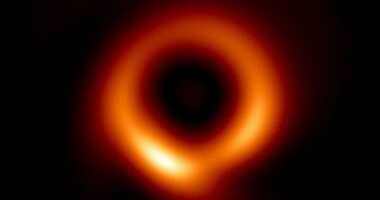A NASA spacecraft that will crash into an asteroid this month to test our planetary defences has snapped its first photo of its target.
The groundbreaking Double Asteroid Redirection Test (DART) mission will hit the binary near-Earth asteroid Didymos this month.
Data will be collected before, during and after the collision to assess whether the cosmic battering ram altered the rock’s orbit.
It’s hoped that similar missions could deflect any planet-destroying asteroids that are on a collision course with Earth in future.
Last week, Nasa shared an image taken by DART of the asteroid Didymos and its moonlet Dimorphos.
It’s the smaller, orbiting moonlet roughly 85 metres across that the spacecraft will impact on September 26.


The contraption’s first photo is a composite of 243 individual images taken by DART’s sole instrument.
That’s a high-resolution camera called the Didymos Reconnaissance and Asteroid Camera for Optical Navigation (DRACO).
The photo was taken on July 27 and released on September 7.
At that point, DART was still 20million miles (32million kilometers) away from the asteroids, so they appear as a single point of light.
Most read in Tech news
As the spacecraft gets closer, fans will be treated to clearer images of the pair, which are a little over six million miles from Earth.
“This first set of images is being used as a test to prove our imaging techniques,” DART engineer Elena Adams of the Johns Hopkins University Applied Physics Laboratory in Maryland, which is managing the mission, said.
“The quality of the image is similar to what we could obtain from ground-based telescopes, but it is important to show that DRACO is working properly and can see its target to make any adjustments needed before we begin using the images to guide the spacecraft into the asteroid autonomously.”
Ultimately, DART will use DRACO to navigate to and smash into Dimorphis independently of mission control back on Earth.
For the time being, however, Nasa will use images snapped by the contraption every five hours to help it find its way to its target.
Within about 24 hours of its dramatic impact, DART will take control to tweak its final approach.
“Seeing the DRACO images of Didymos for the first time, we can iron out the best settings for DRACO and fine-tune the software,” Nasa’s Julie Bellerose said.
“In September, we’ll refine where DART is aiming by getting a more precise determination of Didymos’ location.”
DART mission explained
DART will dramatically smash into an asteroid 6million miles from Earth later this month.
The ambitious project – which involves teams from Nasa and the European Space Agency – is a test of technologies for preventing an impact of Earth by a killer asteroid.
Should it prove successful, it could pave the way for a new planetary defence system that can deflect incoming space rocks before impact.
The scheme mirrors the plot of the 1998 blockbuster flick “Armageddon” in which Nasa flies a spacecraft to an asteroid to stop it from hitting Earth.
“DART will be the first demonstration of the kinetic impactor technique to change the motion of an asteroid in space,” Nasa says on its website.
The DART spacecraft consists of a box-shaped body about twice the size of a washing machine flanked by two, 18-metre-long solar panels.
On November 24, 2021, it launched aboard a SpaceX Falcon 9 rocket from Vandenberg Air Force Base, California.
DART will reach the binary near-Earth asteroid Didymos around nine months later, in September – 11million miles from its home planet.
Didymos is about 740 metres across and sits between the orbits of Earth and Mars. It is not the mission’s primary focus.
Instead, Nasa’s intrepid battering ram will set its sights on a smaller asteroid – or moonlet – orbiting Didymos closely.
DART will smash into the space rock at 15,000mph in an attempt to change its orbital trajectory around its host.
After DART crashes into its target, Nasa and ESA will train telescopes on Earth on it to check whether the scheme has worked.
A tiny probe launched alongside the mission will collect data before, during and after the impact.
“The DART spacecraft will achieve the kinetic impact deflection by deliberately crashing itself into the moonlet at a speed of approximately 6.6 km/s, with the aid of an onboard camera (named DRACO) and sophisticated autonomous navigation software,” Nasa says.
“The collision will change the speed of the moonlet in its orbit around the main body by a fraction of one percent.
“This will change the orbital period of the moonlet by several minutes – enough to be observed and measured using telescopes on Earth.”
Space experts have already identified at least 26,000 so-called “near-Earth objects”.
An estimated 4,700 meet Nasa’s classification as “Potentially Hazardous Objects”.


That means they are larger than 500ft across, pass within 4.7million miles of Earth and would cause devastating damage if they hit.
Didymos is not considered a threat to our planet, but DART promises to help Nasa and ESA build a system to defend Earth from any space rocks that may get a little too close for comfort in future.
Find out more about science
Want to know more about the weird and wonderful world of science? From the Moon to the human body, we have you covered…
We pay for your stories! Do you have a story for The Sun Online Tech & Science team? Email us at [email protected]
This post first appeared on Thesun.co.uk















